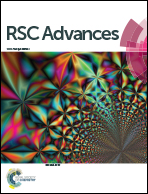Modification of dry/wet hybrid fabrication method for preparing a perovskite absorption layer on a PCBM electron transport layer†
Abstract
The fabrication method of a perovskite absorption layer on a [6,6]-phenyl-C61-butyric acid methyl ester (PCBM) electron transport layer was investigated for application to perovskite/Si tandem photovoltaic devices. A dry/wet hybrid method that involves thermal evaporation of a PbI2 precursor followed by spin coating of an organic cation solution was found to be a useful means to form a perovskite layer without destruction of the underlying PCBM layer. To form the perovskite layer densely packed with crystals of large grain size and having smooth surface morphology, the rotational speed of the spin coating and the mixing ratio of organic cations were carefully modified. By using this modified absorption layer, a photovoltaic device fabricated under atmospheric exposure conditions showed a power conversion efficiency of ∼10.3% without any large hysteresis. These results have great importance to develop a production technology for high performance tandem solar cells.



 Please wait while we load your content...
Please wait while we load your content...